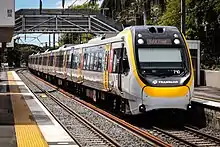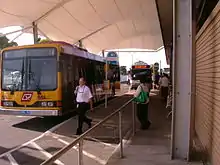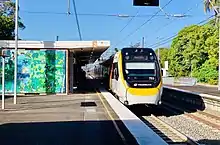Queensland Rail City network
The Queensland Rail City network (formerly known as Citytrain prior to the split of Queensland Rail) provides urban, suburban and inter-urban electric passenger railway services in South East Queensland, Australia.
 | |
| Overview | |
|---|---|
| Owner | Queensland Rail |
| Area served | South East Queensland |
| Transit type | Commuter Rail |
| Number of lines | 13 |
| Number of stations | 152 |
| Annual ridership | 52.44 million (2015/16) |
| Chief executive | Nick Easy |
| Headquarters | Brisbane |
| Website | queenslandrail |
| Operation | |
| Began operation | 1979 |
| Operator(s) | Queensland Rail |
| Technical | |
| System length | 689 km (428 mi) |
| Track gauge | 1,067 mm (3 ft 6 in) |
| Electrification | 25 kV AC |
| Top speed | 140 km/h (87 mph) |
History
The first railway in Queensland did not actually run to Brisbane, but ran from Ipswich to Grandchester which opened in July 1865.[1] The line into Brisbane was not completed until the opening of the Albert Bridge in July 1875.[2]
A start on electrification of the suburban network was approved in 1950 but a change of state government in 1957 saw the scheme abandoned in 1959.[3] It was not until the 1970s that electrification was again brought up, with contracts let in 1975.[4] The first part of the new electric system from Darra to Ferny Grove opened on 17 November 1979.[5][6] The network was completed by 1988, with a number of extensions made since and additional rolling stock purchased. Services were initially operated under the Queensland Rail brand, with the Citytrain name established in 1995.[7]
In June 2009 as part the split of Queensland Rail's commuter rail and the freight business,[8] The Citytrain brand was dropped in favour of using the redesigned Queensland Rail brand. Since then most traces of the Citytrain brand have been removed from rolling stock and station signage.
Network
The Queensland Rail City network is made up of ten suburban lines and three interurban lines. Centering in the Brisbane City, it extends as far as Gympie in the north, Varsity Lakes in the south, Rosewood in the west, and Cleveland in the east to Moreton Bay.[9]
In 2015/16, 52.44 million passenger journeys were made.[10]
Urban
Services that connect Metropolitan Brisbane to the Brisbane CBD. The Caboolture line runs express between Bowen Hills and Petrie, stopping only at Eagle Junction and Northgate. The Redcliffe Peninsula line runs express between Bowen Hills and Northgate, stopping only at Eagle Junction. All other suburban lines are all-stop services with the Cleveland & Ipswich/Rosewood lines having express services during on-peak times.
| Line Colour and Name | Line Description |
|---|---|
| Airport line | Airtrain Citylink service which links the Brisbane CBD to the International and Domestic terminals of the Brisbane Airport. The line from Eagle Junction to the airport is privately owned and the service is provided by Queensland Rail under contract. |
| Beenleigh line | South-eastern railway line that runs through Brisbane's southern suburbs and through Logan to Beenleigh. |
| Caboolture line | Northern railway line which runs through Brisbane's northern suburbs then through the Moreton Bay Region to Caboolture. |
| Cleveland line | Eastern railway line that runs through Brisbane's eastern suburbs and then continues east to Cleveland. |
| Doomben line | Eastern railway line that runs past the Eagle Farm and Doomben racecourses. |
| Exhibition line | Special-purpose railway line used mainly for the Royal Queensland Show and occasionally for other special events. This line branches off at Bowen Hills and continues to drop-off and pick-up stations the Brisbane Exhibition Ground. It then loops back to Roma Street. |
| Ferny Grove line | North-western railway line that runs through Brisbane's western suburbs to Ferny Grove. |
| Ipswich/Rosewood line | South-western railway line that runs through Brisbane's southern suburbs to Ipswich and then continues west to Rosewood. |
| Other lines | Extra services running north and south through the Brisbane CBD. These range from special short-distance services (terminating at or between Northgate, Bowen Hills, Roma Street and Park Road) to existing services terminating at Roma Street. |
| Redcliffe Peninsula line | Eastern railway line which branches off from the Caboolture line after Petrie and then continues through the Redcliffe Peninsula to Kippa-Ring. |
| Shorncliffe line | Northern railway line that runs through Brisbane's northern suburbs to Shorncliffe in the Moreton Bay Region. |
| Springfield line | South-western railway line which branches off from the Ipswich/Rosewood line after Darra and then continues alongside the Centenary Motorway to Springfield Central. |
Interurban
Express services which stop only at major stations linking the Gold Coast, Sunshine Coast and Gympie with Brisbane. The trains used on these lines typically are more designed for long distance travel with more comfortable seating, luggage racks and onboard toilet facilities.
| Line Colour and Name | Line Description |
|---|---|
| Gold Coast line | Continues south from the Beenleigh line to its terminus at Varsity Lakes on the Gold Coast. |
| Sunshine Coast line | Continues north from the Caboolture line through the Sunshine Coast Region to its termini of Nambour and Gympie North. |
RailBus

To relieve congestion on the single track North Coast line north of Beerburrum, the rail service is supplemented by a bus service operated by Kangaroo Bus Lines on weekdays between Caboolture and Nambour as route 649.[11]
Fleet
All of the Queensland Rail City Network rolling stock is electric and air conditioned.
- Electric Multiple Unit (EMU) - 28 in service (88 built)[12]
- Suburban Multiple Unit (SMU)
- Interurban Multiple Unit (IMU)
- InterCity Express (ICE) - 2 two car units plus a trailer (5 cars in total) in service (20 built)[12]
- New Generation Rollingstock
- 700 Series - 75 in service (75 built)
- Rollingstock Expansion Project (Planned)
- 20-45 new EMUs of undecided design

All trains are electric multiple units with a driver cabin at both ends, with the exception of EMU60 through EMU79 having a cab at one end. These units also had only 3 powered bogies (per 3 car set) compared to the 4 powered bogie arrangement for the remaining EMUs. The last of these units, EMU78, was scrapped in August 2020. All All EMU, SMU and IMU units consist of 3 cars, giving a fleet total of 621 cars, plus the 20 ICE cars. The ICE units are usually configured as five car trains.
Suburban trains are occasionally scheduled on interurban lines if other toilet equipped rollingstock is not available. While using suburban trains on interurban lines increases operational flexibility, the trains are not provided with the facilities of the IMU, ICE or NGR units, such as toilets or high-backed seats.
The 260 Series SMU, 160 Series IMU and the NGR all come with free Wi-Fi on board.[13] The Wi-Fi usage is limited to 20MB.[14]
75 new six-car New Generation Rollingstock trains were ordered in January 2014 and were delivered between late 2015 and late 2019.[15] A new maintenance facility for these trains was built at Wulkuraka. The first NGR entered service on December 11, 2017.
To keep up with projected passenger increases 20 to 45 new electric multiple units will be produced in the next decade.
See also
References
- "QR Corporate - QR History - Beginnings". www.corporate.qr.com.au. Archived from the original on 15 January 2010. Retrieved 16 August 2008.
- "QR Corporate - QR History - Building to the bush". www.corporate.qr.com.au. Archived from the original on 22 July 2008. Retrieved 16 August 2008.
- Geoffrey B. Churchman (1995). Railway Electrification in Australia and New Zealand. IPL Books. p. 131. ISBN 0-646-06893-8.
- Geoffrey B. Churchman (1995). Railway Electrification in Australia and New Zealand. IPL Books. p. 132. ISBN 0-646-06893-8.
- "QR Corporate - Modern competitive railway". www.corporate.qr.com.au. Archived from the original on 22 July 2008. Retrieved 16 August 2008.
- "Brisbane Rail Electrification Stages 1 and 2 Armstrong, J Australian Railway Historical Society Bulletin August 1982 pp165-192
- "Annual Report Summaries" Railway Digest February 1996 page 26
- Queensland asset sales to reap $15 billion Archived 19 October 2009 at the Wayback Machine Brisbane Times 2 June 2009
- "QR Citytrain Network Map". Archived from the original on 16 June 2004. Retrieved 25 March 2010.
- Annual Report for year ended 30 June 2016 Archived 13 March 2017 at the Wayback Machine Queensland Rail
- "Route 649 timetable". TransLink.
- "Citytrain fleet". www.queenslandrail.com.au. Archived from the original on 3 July 2016. Retrieved 15 July 2016.
- "QUEENSLAND RAIL COMPLETES ROLL-OUT OF WIFI TRAINS". Archived from the original on 20 May 2013. Retrieved 5 October 2012.
- "Transport Priority in State Budget 2008-09" (PDF). SEQIPRail. QLD Treasury Department. 3 June 2008. Archived (PDF) from the original on 20 July 2008. Retrieved 20 June 2008.
- "New Generation Rollingstock". Department of Transport and Main Roads. Archived from the original on 5 November 2014. Retrieved 5 November 2014.